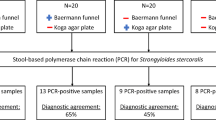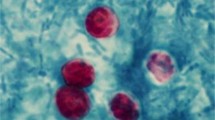Abstract
Dientamoeba fragilis is a pathogenic protozoan parasite that is notoriously difficult to diagnose. The aim of this study was to determine the gold standard for laboratory detection of D. fragilis. A total of 650 human faecal samples were included in the study. All specimens underwent the following: microscopy using a permanent stain (modified iron-haematoxylin), culture using a modified Boeck and Drbohlav’s medium (MBD) and TYGM-9, a conventional polymerase chain reaction (PCR) and a real-time PCR (RT-PCR). The overall prevalence of D. fragilis in the study population was 5.4% (35/650). RT-PCR detected 35 isolates, conventional PCR detected 15 isolates, MBD culture detected 14 isolates, TYGM-9 detected ten isolates, while microscopy detected 12 isolates. RT-PCR detected an additional 15 positive samples compared to the other diagnostic methods, all of which were confirmed by sequencing. When all methods were compared to each other, RT-PCR showed a sensitivity and specificity of 100 and 100%, conventional PCR 42.9 and 100%, MBD culture 40 and 100%, TYGM-9 culture 28.6 and 100%, and microscopy 34.3 and 99%, respectively. These results show that RT-PCR is the diagnostic method of choice for the detection of D. fragilis in clinical samples and, as such, should be considered as the gold standard for diagnosis.

Similar content being viewed by others
References
Stark D, Beebe N, Marriott D, Ellis J, Harkness J (2005) Prospective study of the prevalence, genotyping, and clinical relevance of Dientamoeba fragilis infections in an Australian population. J Clin Microbiol 43(6):2718–2723
Stark D, Beebe N, Marriott D, Ellis J, Harkness J (2007) Dientamoeba fragilis as a cause of travelers’ diarrhea: report of seven cases. J Travel Med 14(1):72–73
Stark DJ, Beebe N, Marriott D, Ellis JT, Harkness J (2006) Dientamoebiasis: clinical importance and recent advances. Trends Parasitol 22(2):92–96
Stark D, Phillips O, Peckett D, Munro U, Marriott D, Harkness J, Ellis J (2008) Gorillas are a host for Dientamoeba fragilis: an update on the life cycle and host distribution. Vet Parasitol 151(1):21–26
Crotti D, D’Annibale ML, Fonzo G, Lalle M, Cacciò SM, Pozio E (2005) Dientamoeba fragilis is more prevalent than Giardia duodenalis in children and adults attending a day care centre in Central Italy. Parasite 12(2):165–170
Walker JC, Bahr G, Ehl AS (1985) Gastrointestinal parasites in Sydney. Med J Aust 143(10):480
Dobell C (1940) Researches on the intestinal protozoa of monkeys and man. X. The life history of Dientamoeba fragilis: observations, experiments, and speculations. Parasitology 32:417–461
Windsor JJ, Johnson EH (1999) Dientamoeba fragilis: the unflagellated human flagellate. Br J Biomed Sci 56(4):293–306
van Gool T, Weijts R, Lommerse E, Mank TG (2003) Triple Faeces Test: an effective tool for detection of intestinal parasites in routine clinical practice. Eur J Clin Microbiol Infect Dis 22(5):284–290
Sawangjaroen N, Luke R, Prociv P (1993) Diagnosis by faecal culture of Dientamoeba fragilis infections in Australian patients with diarrhoea. Trans R Soc Trop Med Hyg 87(2):163–165
Windsor JJ, Macfarlane L, Hughes-Thapa G, Jones SK, Whiteside TM (2003) Detection of Dientamoeba fragilis by culture. Br J Biomed Sci 60(2):79–83
Clark CG, Diamond LS (2002) Methods for cultivation of luminal parasitic protists of clinical importance. Clin Microbiol Rev 15(3):329–341
Stark D, Beebe N, Marriott D, Ellis J, Harkness J (2006) Evaluation of three diagnostic methods, including real-time PCR, for detection of Dientamoeba fragilis in stool specimens. J Clin Microbiol 44(1):232–235
Stark D, Beebe N, Marriott D, Ellis J, Harkness J (2005) Detection of Dientamoeba fragilis in fresh stool specimens using PCR. Int J Parasitol 35(1):57–62
Peek R, Reedeker FR, van Gool T (2004) Direct amplification and genotyping of Dientamoeba fragilis from human stool specimens. J Clin Microbiol 42(2):631–635
Verweij JJ, Mulder B, Poell B, van Middelkoop D, Brienen EA, van Lieshout L (2007) Real-time PCR for the detection of Dientamoeba fragilis in fecal samples. Mol Cell Probes 21(5–6):400–404
Chan FT, Guan MX, Mackenzie AM, Diaz-Mitoma F (1994) Susceptibility testing of Dientamoeba fragilis ATCC 30948 with iodoquinol, paromomycin, tetracycline, and metronidazole. Antimicrob Agents Chemother 38(5):1157–1160
Rayan HZ, Ismail OA, El Gayar EK (2007) Prevalence and clinical features of Dientamoeba fragilis infections in patients suspected to have intestinal parasitic infection. J Egypt Soc Parasitol 37(2):599–608
Vandenberg O, Souayah H, Mouchet F, Dediste A, van Gool T (2007) Treatment of Dientamoeba fragilis infection with paromomycin. Pediatr Infect Dis J 26(1):88–90
Kurt O, Girginkardeşler N, Balcioğlu IC, Ozbilgin A, Ok UZ (2008) A comparison of metronidazole and single-dose ornidazole for the treatment of dientamoebiasis. Clin Microbiol Infect 14(6):601–604
Hiatt RA, Markell EK, Ng E (1995) How many stool examinations are necessary to detect pathogenic intestinal protozoa? Am J Trop Med Hyg 53(1):36–39
Johnson EH, Windsor JJ, Clark CG (2004) Emerging from obscurity: biological, clinical, and diagnostic aspects of Dientamoeba fragilis. Clin Microbiol Rev 17(3):553–570, table of contents
Acknowledgements
This work was supported by grants from the Institute of Laboratory Science at St. Vincent’s Hospital, Sydney, Australia, and the Australian Research Council. We would also like to thank Quoc Nyugen for help with the statistical analysis.
Author information
Authors and Affiliations
Corresponding author
Additional information
The GenBank accession number for the SSU rDNA sequence of Dientamoeba fragilis is FJ649228.
Rights and permissions
About this article
Cite this article
Stark, D., Barratt, J., Roberts, T. et al. Comparison of microscopy, two xenic culture techniques, conventional and real-time PCR for the detection of Dientamoeba fragilis in clinical stool samples. Eur J Clin Microbiol Infect Dis 29, 411–416 (2010). https://doi.org/10.1007/s10096-010-0876-4
Received:
Accepted:
Published:
Issue Date:
DOI: https://doi.org/10.1007/s10096-010-0876-4




